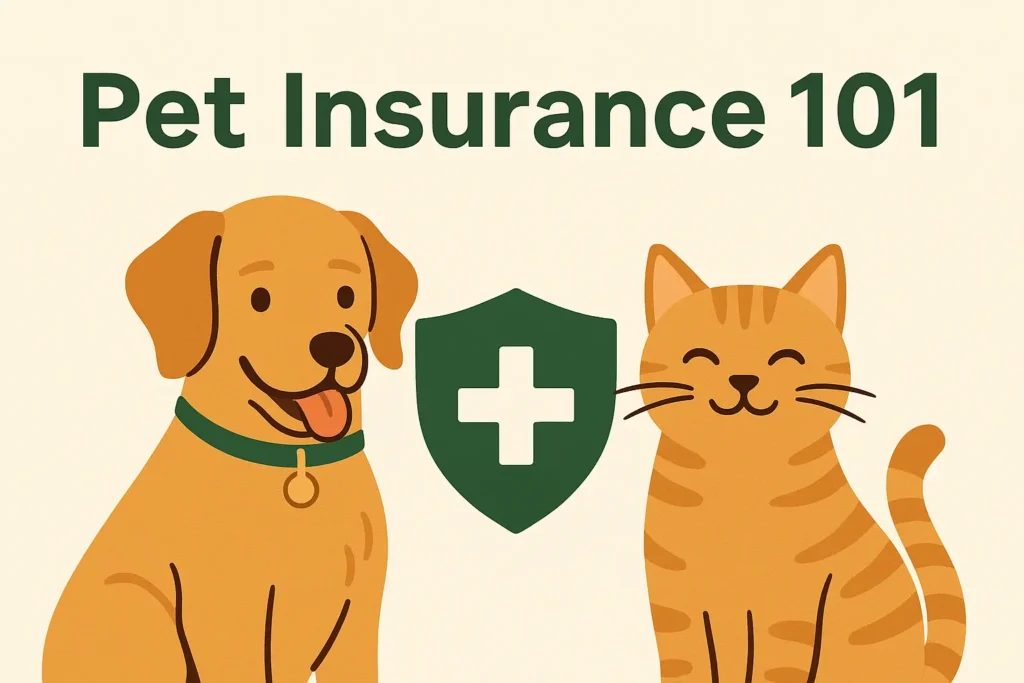Pet Insurance 101: What It Covers, What It Costs, and How to Choose the Right Plan
Thinking about protecting your dog or cat from sky-high vet bills?
Pet insurance can be the safety net that keeps both your budget and your best friend healthy—but only if you understand how coverage, premiums, and deductibles really work.
Table of Contents
- Why Pet Insurance Matters in 2025
- How Pet Insurance Coverage Works
- Premiums, Deductibles & Reimbursement Rates Explained
- Accident-Only vs. Accident-and-Illness Policies
- What Most Policies Don’t Cover
- 5 Steps to Picking the Right Plan
- Frequently Asked Questions
Why Pet Insurance Matters in 2025
A single emergency surgery can cost more than the average American’s monthly rent.
With veterinary technology advancing at lightning speed, treatments that used to be impossible—MRI scans, stem-cell therapy, complex orthopedic surgery—are now routine. That’s fantastic news for pets, but it pushes the average cost of care to record highs:
| Procedure | Typical Bill (USD) |
|---|---|
| Cruciate-ligament repair | $3,500 – $5,000 |
| Cancer chemotherapy | $2,800 – $7,000 |
| Foreign-body removal | $1,800 – $3,200 |
A pet insurance policy shifts most of that risk from your wallet to an insurer, so an unexpected injury never forces you to choose between financial stability and your companion’s life.
How Pet Insurance Coverage Works
- You visit any licensed vet.
- Pay the invoice up front (unless your insurer offers direct pay).
- Submit a digital claim—usually a photo of the receipt.
- The company reimburses you a set percentage (often 70–90 %) minus your deductible.
Key Terms You’ll See in Every Policy
- Coverage – the medical events the policy pays for (e.g., accidents, illnesses, hereditary conditions).
- Annual limit – the maximum payout per policy year—some providers market “unlimited” plans.
- Waiting period – a short window (typically 14 days) before coverage kicks in to deter fraud.
Premiums, Deductibles & Reimbursement Rates Explained
- Premium: Your monthly or annual subscription fee. Factors that raise premiums include purebred status, older age, and big-city ZIP codes.
- Deductible: The amount you pay out-of-pocket each year (or per incident) before reimbursement starts. Higher deductibles mean lower premiums—just like with human health insurance.
- Reimbursement Rate: The percentage of the vet bill an insurer pays after you meet the deductible.
Pro tip: Aim for a deductible you could comfortably cover in an emergency (e.g., $250–$500). Pair it with an 80 % reimbursement rate for balanced protection.
Accident-Only vs. Accident-and-Illness Policies
| Feature | Accident-Only | Accident + Illness |
|---|---|---|
| Broken bones, lacerations | ✔ | ✔ |
| Cancer, diabetes, arthritis | ✖ | ✔ |
| Average monthly premium | $$ | $$$ |
Accident-only plans are budget-friendly but leave you exposed to chronic conditions that account for 73 % of claims, according to industry data. For most pet parents, an accident-and-illness policy offers far better long-term value.
What Most Policies Don’t Cover
- Pre-existing conditions—anything noted on your pet’s medical record before enrollment.
- Routine Wellness—vaccines, flea prevention, dental cleanings (unless you add a wellness rider).
- Elective procedures—tail docking, ear cropping, cosmetic dentistry.
- Breeding or pregnancy costs.
Knowing these exclusions helps you avoid nasty surprises when you file a claim.
5 Steps to Picking the Right Plan
- List your pet’s risk factors—breed-specific issues, lifestyle (indoor vs. adventure dog), age.
- Compare premiums for at least three reputable insurers—use the same deductible and reimbursement settings.
- Check annual limits; aim for $10 k minimum or unlimited.
- Read the fine print on waiting periods and hereditary-condition coverage.
- Lock in while your pet is young. Premiums rise with age; early enrollment also sidesteps pre-existing exclusions.
Need a shortcut? Our Pet Insurance Comparison Tool crunches quotes in under two minutes.
Frequently Asked Questions
Is pet insurance worth it for indoor cats?
Yes—indoor cats still face costly emergencies such as urinary blockages or diabetes. A modest premium can offset four-figure bills.
Can I keep my current vet?
Nearly all U.S. providers let you use any licensed veterinarian—including emergency clinics and specialists.
How fast are claims paid?
Digital claims with leading insurers average 2–5 business days; some offer instant reimbursements via direct deposit.
Final Thoughts
A pet insurance policy isn’t just a line item in your budget—it’s peace of mind that lets you focus on what matters: enjoying life with your four-legged family member. By understanding coverage, premiums, and exclusions now, you’ll avoid financial heartbreak later.
Ready to dive deeper? Explore our in-depth guides to deductibles and wellness add-ons to craft the perfect safety net for your best friend.

